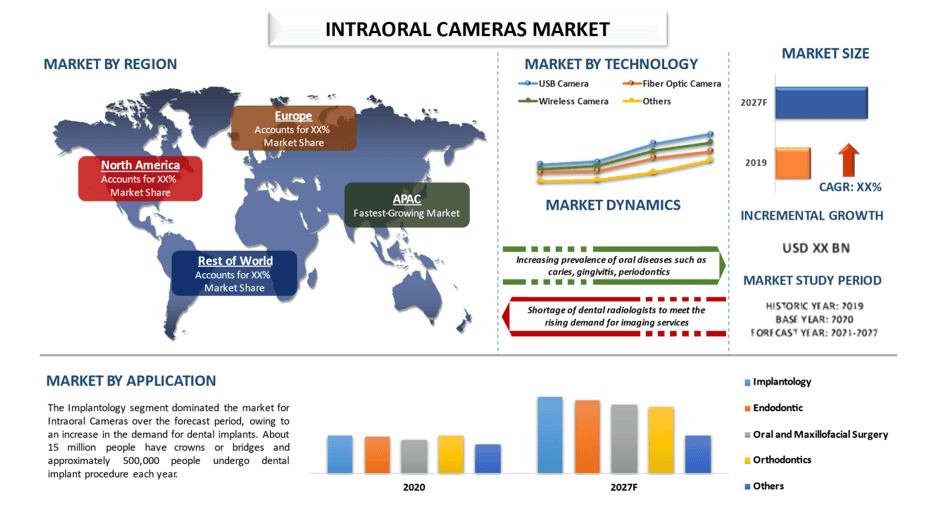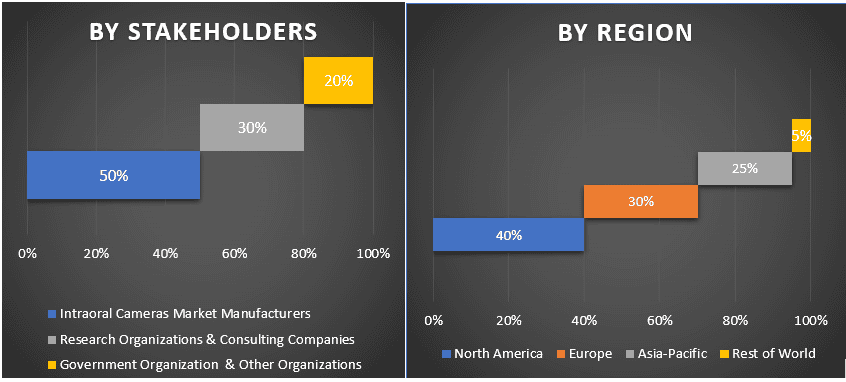- Home
- About Us
- Industry
- Services
- Reading
- Contact Us
Intraoral Cameras Market: Current Analysis and Forecast (2021-2027)
Emphasis on Product type (Intraoral Wand, Single Lens Reflex); Technology (USB Camera, Fiber Optic Camera, Wireless Cameras, Others); Application (Implantology, Endodontic, Oral, And Maxillofacial Surgery, Orthodontics, Others); End User (Dental Hospitals and Clinics, Dental Diagnostic Centers, Dental Academic & Research Institutes, Others); Region/Country (North America (US, Canada, Rest of North America); Europe (Germany, UK, France, Italy, Spain, Rest of Europe); Asia-Pacific (China, India, Japan, Australia, Rest of Asia-Pacific); and Rest of World)

Intraoral Cameras Market is anticipated to display a steady CAGR of 9% over the forecast period (2021-2027)
The global intraoral cameras market is expected to witness robust growth mainly due to the increase in dental/oral diseases and demand for oral care like tooth decay and periodontal disease, and tooth damage such as damaged or chipped teeth. Moreover, the increase in the availability of more advanced technology, growing awareness about these diseases and their management, and the rising geriatric population base are some of the factors likely to boost the Global Intraoral Cameras Market during the forecast period. According to the WHO, the Global Burden of Disease Study (2016) estimated that oral diseases are responsible for affecting half of the world’s population (3.58 billion people), with dental caries (tooth decay) in permanent teeth being the most prevalent condition assessed.
The ongoing COVID-19 pandemic across the world has had a tremendous impact on different spectra of society, the market for Intraoral Cameras no less. The market for Intraoral Cameras faced a negative impact due to, regulators and health authorities have ordered all dental offices to immediately stop seeing patients, except for emergency treatment. Due to this, there has been a negative impact on the product sales and supply chains of numerous sectors, particularly during the first two quarters of the year 2020. This has adversely affected the trade of Intraoral Cameras products due to the lockdown restrictions, & a resurgence in dental visits.
Insights Presented in the Report
“Amongst Product Type, intraoral wand segment dominated the market in 2020”
Based on product type, the intraoral cameras market is segmented into intraoral wand and single-lens reflex. In 2020, the intraoral wand category dominated the market and is expected to maintain its dominance throughout the forecast period. This is mainly due to the rising diagnosis and treatment rate of oral disorders, as these instruments are mainly used to treat dental caries with the help of lasers and a concentrated form of light to capture all the regions of the posterior mouth. Intraoral Wand is the computer-assisted system used in the treatment of dental treatment and it is painless. On the other, Single Lens Reflex is anticipated to grow lucratively over the forecast period.
“Amongst end user, dental diagnostic centers category to witness fastest growth rate”
Based on end user, the market is bifurcated into dental hospitals and clinics, dental diagnostic centers, dental academic and research institutes, and others. Among these, the dental diagnostic centers category is expected to witness robust growth during the forecast period. Furthermore, the presence of well-established infrastructure in dental hospitals, better reimbursement policies, and availability of advanced technologies and well-trained healthcare professionals are also one of the main reasons why patients prefer dental hospitals & clinics for wound care.
“North America will Dominate the Market During the Forecast Period”
For a better understanding of the demand for intraoral cameras market, the market is analyzed for major regions including North America (US, Canada, Rest of North America); Europe (Germany, UK, France, Italy, Rest of Europe); Asia-Pacific (China, India, Japan, Australia, Rest of Asia-Pacific); and Rest of World. Currently, North America dominates the market; however, Asia-Pacific is expected to witness the highest CAGR growth owing to rising healthcare expenditure in countries such as China, India, and other developing Asian countries. Some of the major players operating in the market include Ashtel Dental, Carestream Dental, Owandy Radiology, Danaher Corporation, Dentsply Sirona, Digital Doc LLC, Henry Schein, Imagin Systems Corporation, MouthWatch, Prodent.
Reasons to buy this report:
- The study includes market sizing and forecasting analysis validated by authenticated key industry experts
- The report presents a quick review of overall industry performance at one glance
- The report covers an in-depth analysis of prominent industry peers with a primary focus on key business financials, product portfolio, expansion strategies, and recent developments
- Detailed examination of drivers, restraints, key trends, and opportunities prevailing in the industry
- The study comprehensively covers the market across different segments
- Deep dive regional level analysis of the industry
Customization Options:
The intraoral cameras market can further be customized as per the requirement or any other market segment. Besides this, UMI understands that you may have your own business needs, hence feel free to connect with us to get a report that completely suits your requirements.
Table of Content
Research Methodology for Intraoral Cameras Market Analysis
Analyzing the historical market, estimating of the current market, and forecasting the future of the intraoral cameras market were the three major steps undertaken to create and analyze the demand and sales of intraoral cameras across major regions globally. Exhaustive secondary research was conducted to collect the historical market numbers and estimate the current market size. Secondly, to validate these insights, numerous findings and assumptions were taken into consideration. Moreover, exhaustive primary interviews were conducted, with industry experts across the value chain of the industry. Post assumption and validation of market numbers through primary interviews, we employed a bottom-up approach to forecast the complete market size. Thereafter, market breakdown and data triangulation methods were adopted to estimate and analyze the market size of segments and sub-segments of the industry pertains to. The detailed methodology is explained below.
Seek More Details About Research Methodology
Analysis of Historical Market Size
Step 1: In-Depth Study of Secondary Sources:
Detailed secondary study was conducted to obtain the historical market size of the intraoral cameras through company internal sources such as annual report & financial statements, performance presentations, press releases, etc., and external sources including journals, news & articles, government publications, competitor publications, sector reports, third-party database, and other credible publications.
Step 2: Market Segmentation:
After obtaining the historical market size of the intraoral cameras, we conducted a detailed secondary analysis to gather historical market insights and share for different segments & sub-segments for major regions. Major segments included in the report are product, technology, application, end user, and region. Further regional level analyses were conducted to evaluate the overall demand for intraoral cameras in the global context.
Step 3: Factor Analysis:
After acquiring the historical market size of different segments and sub-segments, we conducted a detailed factor analysis to estimate the current market size. Further, we conducted factor analysis using dependent and independent variables such as industry trends, product application, understanding consumer demands, competitive landscape, brand positioning and pricing analysis. Historical trends and their year-on-year impact on the market size and share was analyzed. Demand and supply side scenario was also thoroughly studied.
Current Market Size Estimate & Forecast
Current Market Sizing: Based on actionable insights from the above 3 steps, we arrived at the current market size, key players in the Market, and market shares of the segments and company. All the required percentage split, and market breakdowns were determined using the above-mentioned secondary approach and were verified through primary interviews.
Estimation & Forecasting: For market estimation and forecast, weights were assigned to different factors including drivers & trends, restraints, and opportunities available for the stakeholders. After analyzing these factors, relevant forecasting techniques i.e., bottom-up approach was applied to arrive at the market forecast to 2027 for different segments and subsegments across the major regions globally. The research methodology adopted to estimate the market size encompasses:
- The industry’s market size, in terms of value (US$) and the demand of intraoral cameras across the major regions globally
- All percentage shares, splits, and breakdowns of market segments and sub-segments
- Key players in the intraoral cameras market in terms of products offered. Also, the growth strategies adopted by these players to compete in the fast-growing market.
Market Size and Share Validation
Primary Research: In-depth interviews were conducted with the Key Opinion Leaders (KOLs) including Top Level Executives (CXO/VPs, Sales Head, Marketing Head, Operational Head, and Regional Head, Country Head, etc.) across major countries. Primary research findings were then summarized, and statistical analysis was performed to prove the stated hypothesis. Inputs from primary research were consolidated with secondary findings, hence turning information into actionable insights.
Split of Primary Participants in Different Regions

Market Engineering
Data triangulation technique was employed to complete the overall market estimation and to arrive at precise statistical numbers of each segment and sub-segment of the intraoral cameras market. Data was split into several segments & sub-segments post studying various parameters and trends in the areas of product, technology, application, end user, and region.
The main objective of the Intraoral Cameras Market Study
The current & future market trends of the intraoral cameras market are pinpointed in the study. Investors can gain strategic insights to base their discretion for investments from the qualitative and quantitative analysis performed in the study. Current and future market trends would determine the overall attractiveness of the market at a regional level, providing a platform for the industrial participant to exploit the untapped market to benefit as a first-mover advantage. Other quantitative goals of the studies include:
- Analyze the current and forecast market size of intraoral cameras in terms of value (USD). Also, analyze the current and forecast market size of different segments and sub-segments of the industry
- Segments in the study include product, technology, application, end user, and region
- Defined analysis of the regulatory framework for the intraoral camera’s industry
- Analyze the value chain involved with the presence of various intermediaries, along with analyzing customer and competitor behaviors pertaining to the industry
- Analyze the current and forecast market size of the intraoral cameras across the globe. Major regions analyzed in the report include North America (US, Canada, Rest of North America); Europe (Germany, UK, France, Italy, Rest of Europe); Asia-Pacific (China, India, Japan, Australia, Rest of Asia-Pacific); and Rest of World. Define and analyze the competitive landscape of the intraoral cameras sector and the growth strategies adopted by the market players to sustain in the fast-growing market
Deep dive regional level analysis of the industry
Related Reports
Customers who bought this item also bought










